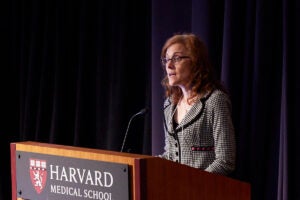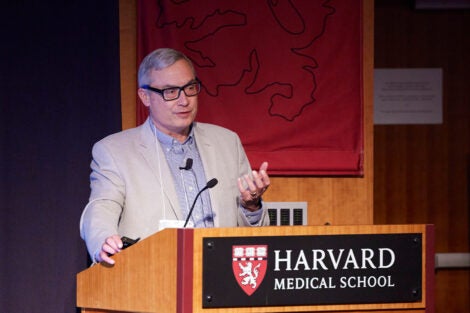May 24, 2023 – In the field of microbiome science, researchers have long focused on studying the bacteria that live inside and on the human body. But other types of microbes also play an important role in human health and disease, including viruses—both phage viruses that infect bacteria and eukaryotic viruses that infect human cells—and fungi.
These lesser-studied microbes were the focus of the fifth annual symposium of the Harvard Chan Microbiome in Public Health Center (HCMPH), held May 15 at Harvard Medical School’s Joseph B. Martin Center.
“While bacterial members of microbiome studies remain very important, we wanted to shine a light on … the fungal world, the viral phage and eukaryotic viruses, and importantly, cross-kingdom interactions—so not only how our various microbial biomes interact with us as hosts, but also interactions between members of the microbial world, be it bacteria and viruses or bacteria and fungi,” said Wendy Garrett, Irene Heinz Given Professor of Immunology and Infectious Diseases and co-director of HCMPH, in her welcome remarks. Garrett and Curtis Huttenhower, professor of computational biology and bioinformatics and co-director of HCMPH, were co-organizers of the symposium.

The human microbiome plays an important role in health and disease, such as priming an infant’s developing immune system to fight infection, according to keynote speaker Joseph Petrosino, a professor and chair of the Department of Molecular Virology and Microbiology at the Baylor College of Medicine.
“If the [microbiome] system is somehow disrupted, then the opposite occurs—you make yourself susceptible to infectious disease, allergies, and a variety of disorders that we’re only starting to begin to understand,” Petrosino said.
In his research, Petrosino has found that many environmental factors affect the species and levels of microbes in the infant gut microbiome, including whether infants are breastfed, take antibiotics, or have contact with siblings or pets. He has identified potential associations between the presence of certain gut microbes and diseases such as type 1 diabetes and asthma, but he said that further studies are needed to determine the exact nature of the relationships.
Another keynote speaker, Rick Bushman, the William Maul Measey Professor and chair of the Department of Microbiology at the University of Pennsylvania, also shared his research about the gut microbiome in newborn infants. His studies support what he calls the “surprisingly controversial” sterile womb hypothesis, which suggests that infants’ bodies do not contain microbes while in the womb, but rather get colonized with them after birth.
Bushman has found that soon after birth, the first types of viruses that appear in the infant’s gut microbiome are phages that infect bacterial members of the microbiome. By one month after birth, there is a greater presence of eukaryotic viruses that have the potential to infect human cells.
Bushman has also conducted research comparing the levels of human viruses in infants who were fed with breastmilk versus formula. He found that breastfeeding was linked with lower levels of these viruses, potentially protecting against infections such as gastroenteritis. He noted that a combination of formula and breastfeeding was still protective. “If mothers are having trouble doing exclusive breastfeeding, it seemed like it was helpful to do at least partial breastfeeding,” he said.
Other talks at the symposium covered a variety of topics, including the challenge of studying microbes that cannot be cultured in a lab, and how analyzing genomic data can help address the issue; how the skin acts as a reservoir for a multi-drug resistant fungal pathogen that transmits in nursing homes and hospitals; and how two particular species of fungus and bacteria work together to cause disease.
– Jay Lau
Photos: Kent Dayton
